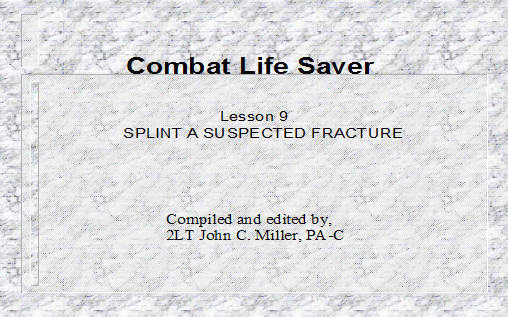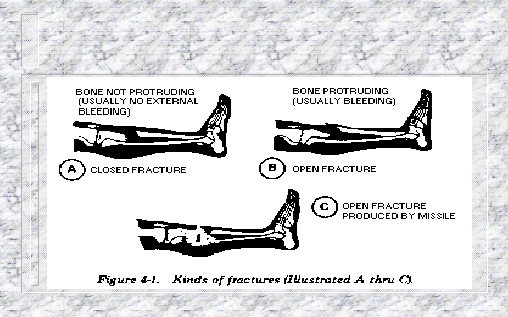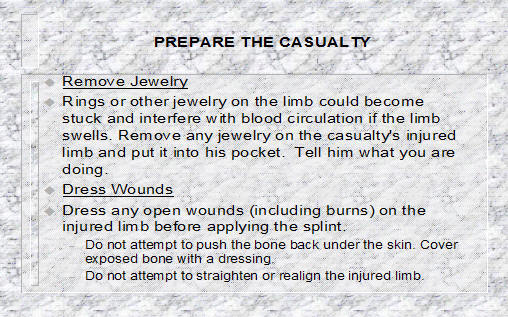Splint a Suspected Fracture
Click here to download the presentation.



Lesson 9
SPLINT A SUSPECTED FRACTURE
INTRODUCTION
A fracture is a break in a bone. It can cause disability and even death. A closed fracture is a break in the bone without a break in the skin. An open fracture is a break in the bone with a break in the overlying skin. Dislocations and sprains are injuries to joints which are treated as though they were fractures.
SPLINT A SUSPECTED FRACTURE
TASK
Splint a suspected fracture of the arm or leg.
CONDITION
Given a simulated casualty with a suspected fracture of the arm or leg and needed materials.
STANDARD
Score a GO on the performance checklist.
IDENTIFY SIGNS AND SYMPTOMS OF A
FRACTURED ARM OR LEG
Bone sticking through the skin.
Pain, tenderness, swelling, and/or bruise at a particular location.
Arm or leg appears shorter or is in an abnormal position (looks deformed).
Difficulty in moving an arm or leg.
Do not have the casualty attempt to move the injured arm or leg. Rely upon what the casualty tells you.
Massive injury to an arm or leg.
“Snapping” sound may be heard by the casualty at the time of the injury.
PREPARE THE CASUALTY
Reassure the Casualty
Tell the casualty that you are taking care of him.
If you must leave the casualty to locate materials needed to make a splint, tell him that you will return quickly.
Locate Site of Fracture
Open fracture — where the bone has broken the skin.
Closed fracture — where the pain, tenderness, bruise, abnormal bend in arm, or other indicator is located.
PREPARE THE CASUALTY
Check Circulation Below Fracture
Indications of poor circulation include:
Lack of a pulse or a weak pulse below the fracture site.
Slow capillary fill. Press on a fingernail on the injured limb and the corresponding nail on the uninjured limb. Release both nails at the same time. Blood flow is hampered if color returns to the uninjured limb first.
PREPARE THE CASUALTY
Numbness or tingling.
Pale, white, or bluish-gray skin color below the fracture site.
Skin below the fracture site is cooler than the skin on the corresponding location of the uninjured limb.
If the limb has poor circulation, evacuate the casualty as soon as possible.
PREPARE THE CASUALTY
Loosen Clothing
Loosen any clothing that is tight or which binds the casualty.
Boots should not be removed unless they are needed to immobilize an injured neck or unless there is actual bleeding from the foot.
Do not remove or loosen any of the casualty’s protective clothing if you are in a chemical environment.
PREPARE THE CASUALTY
Remove Jewelry
Rings or other jewelry on the limb could become stuck and interfere with blood circulation if the limb swells. Remove any jewelry on the casualty’s injured limb and put it into his pocket. Tell him what you are doing.
Dress Wounds
Dress any open wounds (including burns) on the injured limb before applying the splint.
Do not attempt to push the bone back under the skin. Cover exposed bone with a dressing.
Do not attempt to straighten or realign the injured limb.
GATHER SPLINTING MATERIALS
Rigid Objects
Tree branches, poles, boards, sticks, or other rigid objects can be used.
The casualty’s own chest can be used to immobilize a fractured arm and an uninjured leg can be used to immobilize a fractured leg.
Padding.
Blankets, jackets, ponchos, extra clothing, shelter halves, leafy plants, or the casualty’s trouser leg or shirt sleeve can be used.
GATHER SPLINTING MATERIALS
Securing Materials
Cravats made from muslin bandages or other material are preferred.
Cut or tear a square about 3 feet on each side from pliable material such as a shirt or sheet if muslin bandages are not used.
Fold the square along the diagonal to form a triangle.
Cut along the fold so that two triangles are formed. (Each triangle becomes a cravat.)
Fold top of the triangle down until the tip of the triangle touches the base (longest side).
Fold a second time and a third time.
GATHER SPLINTING MATERIALS
Strips of clothing, belts, pistol belts, bandoleers, and similar materials can be used.
Narrow materials such as wire and cord should not be used since they could interfere with blood circulation.
SPLINT THE LIMB
Do not try to straighten or reposition the fractured limb. Splint the limb in the position you find it. Move the limb as little as possible while applying and securing the splint.
Position the Securing Materials
Push the cravats under natural body curvatures, then gently move the securing materials up or down the limb until they are in proper position.
SPLINT THE LIMB
Place at least one cravat (two if possible) above the fracture site and at least one cravat (two if possible) below the fracture site.
If possible, place one cravat above the upper joint, one between the upper joint and the fracture, one between the fracture and the lower joint, and one below the lower joint.
Do not place a cravat directly under the fracture site.
SPLINT THE LIMB
Position the Rigid Objects
If two rigid objects are available, place one on each side of the injured limb.
When possible, position the rigid objects so the joint above the fracture and the joint below the fracture can be immobilized.
Make sure the ends of the rigid objects are not pressing against the armpit or groin.
SPLINT THE LIMB
Apply Padding
Place padding between the rigid objects and the limb.
Place extra padding at bony or sensitive areas such as the elbow, wrist, knee, ankle, groin, or armpit.
SPLINT THE LIMB
Secure the Rigid Objects
Wrap the cravats around the rigid objects and limb to secure the rigid objects and immobilize the limb.
Tie the ends (tails) of each cravat in a nonslip knot on the outer rigid object and away from the casualty.
The securing material should be tight enough to hold the rigid objects securely in place, but not tight enough to interfere with blood circulation.
SPLINT THE LIMB
Check Circulation
Observe the limb below the cravats for signs of impaired circulation as you secure the rigid objects. If possible, check the circulation after each cravat is tied. Recheck the limb for numbness, color, temperature, and pulse after the cravats have been applied.
SPLINT THE LIMB
Loosen the Securing Materials, If Needed
If your first check showed normal circulation and your check now shows poor circulation, untie the cravats. Reposition any rigid object which could interfere with circulation, such as one pressing against the armpit or groin. Add padding, if needed. Retie the cravats and recheck the circulation.
If the limb still has poor circulation, evacuate the casualty as soon as possible.
APPLY A SLING AND SWATHE TO A
FRACTURED ARM
If the elbow is not fractured, form a sling for the fractured arm. A jacket flap sling can be used if no materials are available for a triangular sling.
If the elbow is fractured, splint the arm in the position found. Do not bend the elbow to fit the arm into a sling.
Apply a Triangular Bandage Sling
Form a triangular cloth from a muslin bandage or other material (same as making a triangular bandage for a cravat or tourniquet band).
APPLY A SLING AND SWATHE TO A
FRACTURED ARM
Insert the material under the injured arm so the arm is in the center, the apex of the sling is beyond the elbow, and the top corner of the material is over the shoulder of the injured side.
Position the forearm with the hand slightly raised (about 10 degree angle).
Bring the lower portion of the material over the injured arm and over the shoulder of the uninjured side.
Tie the two corners in a nonslip knot on the side of the neck on the uninjured side.
Twist the apex of the sling and tuck it in at the elbow.
APPLY A SLING AND SWATHE TO A
FRACTURED ARM
Apply a Jacket Flap Sling
Position the forearm on the casualty’s chest with the hand positioned slightly higher than the elbow.
Undo the lower part of the casualty’s BDU or field jacket (coat).
Bring the flap up over the forearm to the pocket area.
Position the elbow so it will not slip out of the sling.
Secure the flap by pushing a stick or other rigid object through the flap and the upper portion of the jacket.
APPLY A SLING AND SWATHE TO A
FRACTURED ARM
Apply Swathes
Use a large strip of cloth, muslin bandage, field dressing, blanket strip, pistol belt, trouser belt, bandoleer, or other wide material as the swathe.
Place one end of the swathe at the breast pocket nearest the uninjured arm.
Wrap the swathe across the sling, around the upper arm on the injured side, behind the casualty’s back, under the uninjured arm, and back to the breast pocket.
Do not apply a swathe on top of the fracture site.
APPLY A SLING AND SWATHE TO A
FRACTURED ARM
Tie the two ends in a nonslip knot over the breast pocket on the uninjured side.
Two swathes, one above the fracture and one below the fracture, are normally applied when the chest is used as a rigid object for splinting
Other Splints
The following splints are found in FM 21-11
SPLINT A SUSPECTED FRACTURE
CLOSING
Even if the arm or leg is not broken, the pain caused by a severe wound can be lessened if the arm or leg is splinted after it has been dressed and bandaged. A fractured limb may need to be splinted before the casualty is repositioned to treat or prevent shock.
Questions